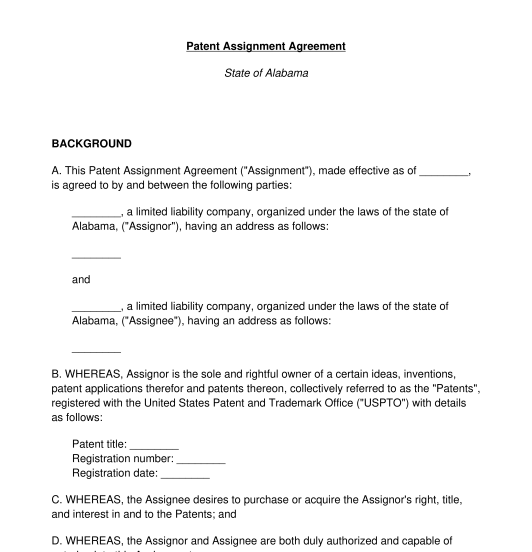 09/10/2025
09/10/2025

Answer a few questions and your document is created automatically.

Your document is ready! You will receive it in Word and PDF formats. You will be able to modify it.

 09/10/2025
09/10/2025
 Word and PDF
Word and PDF
 5 to 6 pages
5 to 6 pages



This Patent Assignment Agreement is a comprehensive document designed to facilitate the transfer of patent ownership from the original patent owner, known as the assignor, to another party, known as the assignee.
A patent is a legal grant issued by the United States Patent and Trademark Office (USPTO) to an inventor, providing exclusive rights to make, use, and sell their invention for a limited period, typically 20 years from the filing date. This protection is granted in exchange for the public disclosure of the invention. This system encourages innovation and lets inventors benefit from their creations for a specified period of time.
An assignment is the legal transfer of ownership or rights of a patent from one party (assignor) to another (assignee). Using a Patent Assignment Agreement, the assignor forever relinquishes their rights to the patent, and the assignee assumes control and ownership of those rights for the duration of the patent.
This assignment can be made either before or after a patent application has been issued as a patent. By law, a patent is considered personal property and, so, can be sold or transferred in the same way one could sell a car or a piece of furniture. This document formally initiates the transfer process, providing clarity and protection for both parties involved. This agreement is particularly useful when inventors, companies, or individuals who wish to transfer their patent rights, whether for financial considerations, strategic partnerships, or other business transactions.
This document is different from a Trademark Assignment Agreement, which is used for the transfer of a different kind of intellectual property, known as a trademark. A trademark is usually a brand name or logo, unlike a patent, which is usually an invention of some sort. This is also slightly different from an Intellectual Property Release. Although that form could be used for a patent, it is generally used for copyrighted material, like works of art or pieces of music. In that case, payment is not made and, instead, the copyrighted works are simply "released," or given to another party. This document can also be distinguished from an Intellectual Property Permission Letter, as there, one party is writing to request permission to use the intellectual property of another. The Patent Assignment Agreement would then come after the letter, but the letter is not the formal legal document that initiates the transfer.
This document includes all the information necessary to transfer the ownership of a patent from one party to another. This document should be used when the transfer will be permanent, usually for a one-time fee, and no royalties will be due after the assignment. This document allows the parties to fill in details of the patent to be transferred, such as the patent name, original recordation number, and date the patent was initially issued. This ensures that everything needed for new recordation with the United States Patent and Trademark Office (USPTO) is present.
Once the document has been completed, both parties should sign the document in front of a notary and have the notary complete the notary page. The document must then be recorded with the USPTO within three months of its signing, or it becomes void. The current cost for filing an assignment with the USPTO is $40 per patent. The assignment can be filed either online or by mail.
In the United States, specific federal laws govern patent assignments, primarily under Title 35 of the United States Code, which pertains to the country's patent system. Section 261 of Title 35 outlines the general provisions related to patent ownership and transfers. According to this statute, patent assignments must be in writing to be valid, and they require the signature of the owner of the patent or their authorized representative. The law also specifies that the assignment must be recorded with the USPTO to establish priority and provide notice to the public.
You fill out a form. The document is created before your eyes as you respond to the questions.
At the end, you receive it in Word and PDF formats. You can modify it and reuse it.
Patent Assignment Agreement - FREE - Sample, template
Country: United States